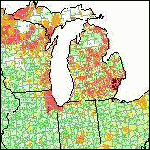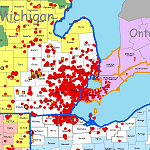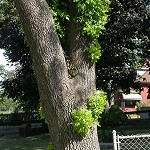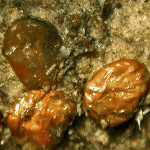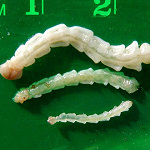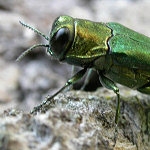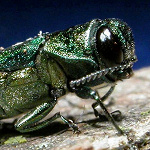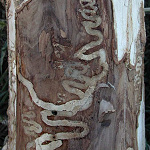Emerald ash borer
In the summer of 2002, scientists realized that widespread damage to ash (Fraxinus) in southern Michigan was caused
by an introduced insect, the emerald ash borer (Federal Register, October 14, 2003, Volume 68, Number 198). The pest is
thought to have been established in Michigan for at least five years by the time of its discovery. By the time the beetle
was detected in Michigan and adjacent Ontario, it had already infested a large area. Since then it has spread further.
By the summer of 2008, the known infestation affected more than 60,000 square miles (Lucik, 2007) in the lower
peninsula of Michigan, neighboring Ontario and northern Indiana and Ohio, spreading into far western Pennsylvania;
with apparently isolated outbreaks in northern Illinois, Maryland, Missouri, Virginia, West Virginia, and Wisconsin.
In Canada, outbreaks have been detected near Ottawa and Montreal--the latter outbreak is near the border with New York and
Vermont (Stubbings, 2008). As results are collated from the 2008 detection trapping program, additional infested sites are
likely to be identified. Since its discovery, emerald ash borer
has killed more than 20 million ash trees in Michigan, Ohio and Indiana (USDA APHIS 2007). The Great Plains Tree and
Forest Invasives Initiative, a multistate coalition funded by a U.S. Forest Service Grant, estimates that emerald
ash borer has killed more than 50 million ash trees in North America (GPTFII, 2008).
As the emerald ash borer spreads, the
damage will mount: an estimated 7.5 billion ash trees are found on timberlands in US (USDA APHIS 2007); an additional
30-90 million trees are planted in urban areas (USDA APHIS 2007). Millions more ash grow in Canada. In addition, ash
trees are widely planted in urban and suburban areas because they are naturally resistant to other tree pests and withstand
urban environments.
The emerald ash borer is indigenous to Asia and known to occur in China, Korea, Japan, Mongolia, the Russian Far East,
and Taiwan. It was probably introduced to North America in wood packaging; USDA APHIS has intercepted the insect 36
times, at ports in eleven eastern states. Those shipments originated from at least eleven countries
(Federal Register: October 14, 2003 (Volume 68, Number 198)).
Larvae feed in the phloem and outer sapwood, producing galleries that damage and eventually kill the host. Adults
feed on host foliage. In North America the borer has been found only on ash species, but the pest feeds on elm
(Ulmus) and Juglandaceae species (walnuts and hickories) in its native range in east Asia
(McCullough & Roberts, 2002a and 2002b).
Eradication is no longer feasible for the emerald ash borer. Current programs focus on curtailing human movement of the
insect to new areas, eradication of outlying or isolated outbreaks, and research into long-term control measures including
biological control. Eradication of outlying or isolated outbreaks is rarely attempted now.
The insect's spread has already been accelerated by human-assisted movement and trade of nursery
stock, lumber, logs, and solid wood packing materials--especially if those materials include bark. Movement of infested
nursery stock was the source of the Maryland infestation and several others in the upper Midwest; in the Maryland case
the nursery owner was fined
(www.aphis.usda.gov/ppq/ep/eab/background.html).
In October 2003, APHIS established a federal quarantine on the movement of firewood derived from any hardwood tree, as
well as ash nursery stock, green lumber, and other material, including logs, stumps, roots, branches, and composted and
uncomposted chips (Federal Register, October 14, 2003 (Volume 68, Number 198)). This quarantine now applies to the
entire states of Indiana, Illinois, and Ohio; the lower peninsula of Michigan; and the isolated outbreaks in other states.
Other regulations restrict importation of ash wood and nursery stock from Ontario. At the meeting of the National Plant
Board in August 2008, representatives of the Customs and Border Protection bureau in the Department of Homeland
Security and of state departments of Agriculture asked APHIS to strengthen the regulations governing imports of
firewood from Canada.
Ash is a vital component of the urban forest in many parts of the country. Assuming that the emerald ash borer is capable
of spreading through all urban areas of the lower 48 states and destroying all urban ash trees, the United States could
suffer a national undiscounted loss of $20 to $60 billion (Federal Register, October 14, 2003 (Volume 68, Number 198)).
Removing dead or infested trees is costly and inconvenient, and replacement trees will have to grow for years before
they offer the same amount of shade and ornamental value. Loss of mature trees lowers property values (Federal Register:
October 14, 2003 (Volume 68, Number 198)). Towns in the Midwest and Plains states would be particularly hard-hit.
Chicago alone has more than 600,000 ash trees (Nowak, 2008).
Ash trees are important members of deciduous forests, riparian and wetland vegetation across North America and are
co-dominants (for example with maples (Acer) and
beeches (Fagus)) in some ecological communities. There are seventeen ash species in North America north of
Mexico (Kartesz, 1994) and it is possible the emerald ash borer will attack them all, although susceptibility apparently
varies (Haack et al., 2004; McCullough, 2004). Trees near forest edges are extremely susceptible to being killed.
Emerald ash borer has also been found deep within forests in the infested region but seems to kill a lower percentage of
ash trees in these situations or at least to take more time to kill them (F. Sapio, pers. comm., 2004). Unfortunately,
forests in the eastern half of the nation are mostly fragmented patches in which emerald ash borer kill rates are
likely to be high. Ash trees that dominate riparian forests on the Pacific slope and the southwestern deserts could also
suffer high mortality rates.
Many Lepidoptera (butterflies and moths) are wholly dependent on (Fraxinus spp).
Sources
Cappaert, David. 2004. Dept. of Entomology, Michigan State University, personal communication.
Eggert, Paul. June 2004. USDA, APHIS, personal communication.
The Federal Register. October 14, 2003 (Volume 68, Number 198). fr14oc03R Emerald Ash Borer;
Quarantine and Regulations (available by using search engines/retrieval services at
http://www.gpoaccess.gov/fr/index.html).
GPTFII 2008. Emerald Ash Borer Fact Sheet. Great Plains Tree and Forest Invasives Initiative. June 2008.
Haack, R. A., T. R. Petrice, D. L. Miller, L. S., Bauer and N. M. Schiff. 2004. Host range of Emerald
Ash Borer. p. 38 In V. Mastro and R. Reardon (compilers) Emerald Ash Borer research and
technology development meeting, Port Huron Michigan, Sept 30-Oct 1, 2003. USDA Forest
Service publication FHTET-2004-02.
Kartesz, J.T. 1994. A synonymized checklist of the vascular flora of the United States, Canada, and Greenland.
Second editon. Timber Press. Portland, OR.
Lucik, Sharon. 2007. Public Affairs Specialist, United States Department of Agriculture Animal & Plant Health Inspection
Service, pers. comm. March 12, 2007.
McCullough, D. G., A. Agius, D. Cappaert, T. Poland, D. Miller and L. Bauer. 2004. Host range
and host preference of Emerald Ash Borer. pp. 39-40 In V. Mastro and R. Reardon (compilers)
Emerald Ash Borer research and technology development meeting, Port Huron Michigan, Sept
30-Oct 1, 2003. USDA Forest Service publication FHTET-2004-02.
McCullough, D. G., and D. L. Roberts. 2002a. Manuscript Draft for USDA Pest Alert on the emerald
ash borer. Deborah McCullough at Department of Entomology, Michigan State University.
McCullough, D. G., and D. L. Roberts. 2002b. Emerald ash borer. Pest Alert. USDA Forest Service,
Northeastern Area, State and Private Forestry, 2 pp.
http://www.na.fs.fed.us/spfo/pubs/pest_al/eab/eab.pdf.
Nowak, D.J. 2008. Money Matters: $ Facts about ash trees and EAB. Illinois Dept. of Natural Resources.
http://dnr.state.il.us/conservation/forestry/Urban/Includes/MoneyMattersUpdate.htm, accessed August 2008.
Sapio, F. 2004. Personal communication.
Stubbings, G. 2008. Dir. of Plant Health for the Canadian Food Inspection Agency. Personal communication, August 2008.
USDA Animal and Plant Health Inspection Service. Emerald Ash Borer Cooperative Eradication Program
in the Lower Michigan Peninsula, Environmental Assessment December 2003.
USDA Animal and Plant Health Inspection Service. 2007. Proposed Release of Three Parasitoids for the Biological Control of
Emerald Ash Borer (Agrilus planipennis) in the Continental United States. Environmental Assessment. April 2, 2007.


